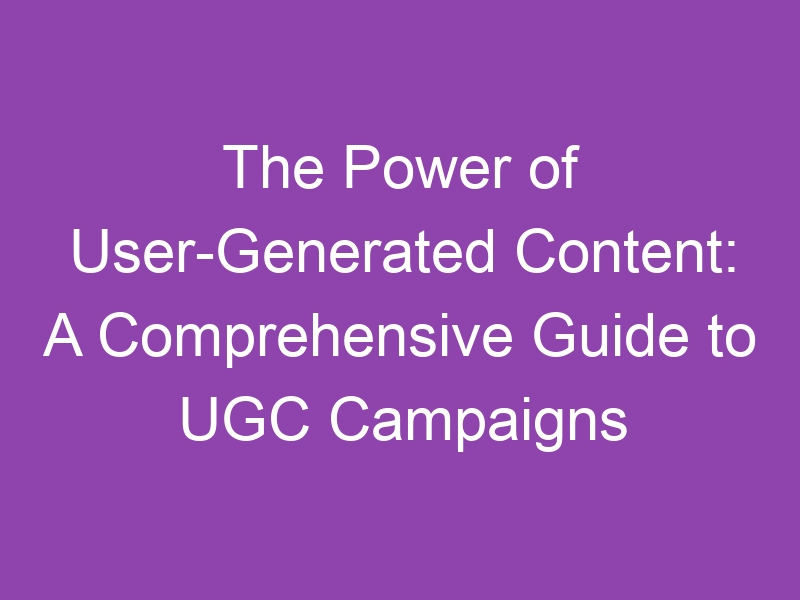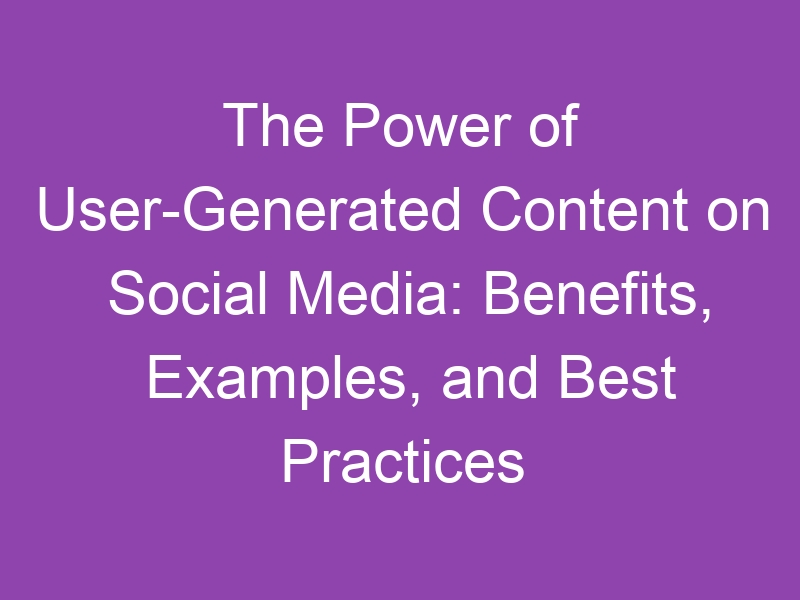Content Outline
- Introduction
- A. Definition of UGC Journey
- B. Importance of UGC Journey
- The Beginning of a UGC Journey
- Benefits of UGC Journey
- Examples of Successful UGC Journeys
Introduction
Welcome to our guide on the UGC journey. User-generated content (UGC) has become an essential part of today’s digital marketing landscape. As consumers continue to rely on social proof and recommendations from their peers, brands have realized the power of UGC in driving conversions and building trust with their audience. In this guide, we will take you through the different stages of the UGC journey and provide you with actionable tips to help you leverage UGC effectively.
- In the first stage of the UGC journey, brands need to encourage their audience to create and share content related to their products or services.
- Once the UGC is generated, brands need to curate and moderate the content to ensure it aligns with their brand values.
- The next step is to showcase the UGC to their audience through various channels such as social media, email marketing, and website galleries.
- Finally, brands need to measure the impact of their UGC efforts and use data to optimize their strategy.
According to a study by Stackla, UGC can increase conversions by 4.6 times compared to traditional marketing tactics. This is because UGC is seen as more authentic and trustworthy by consumers. However, it is important to note that there are tradeoffs involved in the UGC journey. Brands need to balance the benefits of UGC with the potential risks such as negative comments and legal issues.
Stay tuned for the next section where we will dive deeper into the first stage of the UGC journey: encouraging your audience to create and share content.
Introduction – A. Definition of UGC Journey
The term UGC journey refers to the process that user-generated content (UGC) goes through from creation to publication. UGC refers to any type of content, such as images, videos, or text, that is created by users or customers rather than by a company or organization itself.
In recent years, the proliferation of social media and other online platforms has led to a significant increase in the amount of UGC that is created and shared online. This has created new opportunities for businesses to engage with their audiences and to build brand awareness through the use of UGC.
However, managing UGC can be challenging, and there are a number of factors that need to be considered in order to ensure that UGC is used effectively and appropriately. Some of the key factors to consider include:
- The legal implications of using UGC, including issues related to copyright and intellectual property rights
- The potential risks associated with UGC, such as the possibility of negative comments or reviews
- The importance of monitoring and responding to UGC in a timely manner
- The need to develop a clear strategy for incorporating UGC into a company’s overall marketing and branding efforts
Despite these challenges, the benefits of using UGC can be significant. Research has shown that UGC can be more engaging and effective than traditional marketing tactics, and can help to build trust and credibility with customers. In fact, a recent survey found that 85% of consumers find UGC more influential than brand-generated content.
Overall, the UGC journey is an important aspect of modern marketing and branding efforts. By understanding the key factors involved in managing and using UGC effectively, businesses can leverage this powerful tool to build stronger connections with their audiences and to drive business growth.
Sources:
- Forbes – User-Generated Content: How To Safely Navigate The Legal Implications
- Sprout Social – 26 User-Generated Content Statistics to Know in 2021
Introduction – B. Importance of UGC Journey
The journey of User Generated Content (UGC) has become increasingly important over the years. UGC refers to any type of content created and shared by users of an online platform or social media network. The importance of UGC can be seen in the following ways:
- Improved engagement: UGC can improve engagement on websites and social media platforms. When users create and share content, it can lead to increased interaction and participation from other users.
- Authenticity: UGC is often seen as more authentic than branded content. This is because it is created by real people and not a marketing team. As a result, it can be more appealing to consumers.
- Cost-effective: UGC can be a cost-effective way for brands to create content. Rather than hiring a professional content creator or marketing team, brands can rely on their customers to create content for them.
- SEO benefits: UGC can also have SEO benefits. When users create content and share it on social media platforms or websites, it can lead to increased backlinks and improved search engine rankings.
Overall, the importance of UGC journey cannot be overstated. It can lead to improved engagement, authenticity, cost-effectiveness, and SEO benefits for brands. By incorporating UGC into their marketing strategies, brands can leverage the power of their customers to create compelling content that resonates with their target audience.

For more information on the importance of UGC journey, check out this article on the Huffington Post.
The Beginning of a UGC Journey
User-generated content (UGC) has become an essential part of today’s digital landscape. It is a powerful tool for businesses to engage with their audience, build brand awareness, and increase sales. The journey towards integrating UGC into your marketing strategy can be challenging, but it’s worth the effort.
Why UGC Matters
- UGC is trusted more than traditional advertising. According to a study by Stackla, 86% of consumers say authenticity is important when deciding what brands they like and support.
- UGC increases engagement. When customers see their content featured on a brand’s website or social media channels, they are more likely to engage with it.
- UGC is cost-effective. Creating your own content can be expensive, but UGC is often free or low-cost.
The Challenges of UGC
While UGC can bring many benefits, it is not without its challenges. Here are a few key considerations:
- Legal issues: Make sure you have the right to use the content and consider implementing a clear set of guidelines for what is acceptable to share.
- Moderation: It’s important to monitor UGC to ensure that it aligns with your brand values and doesn’t include any offensive or inappropriate content.
- Quality control: Not all UGC will be of high quality, so it’s important to have a process in place for selecting and featuring the best content.
The Next Steps
If you’re ready to embark on a UGC journey, the first step is to define your goals and audience. Then, consider which platforms make sense for your brand and start encouraging customers to create and share content. Finally, make sure to measure your results and adjust your strategy as needed.
Overall, incorporating UGC into your marketing strategy can be a powerful way to build brand trust and increase engagement. By understanding the benefits and challenges of UGC, you can create a successful strategy that resonates with your audience.
Sources:
Benefits of UGC Journey
User-generated content (UGC) has become a crucial part of modern marketing strategies due to its numerous benefits. UGC journey refers to the process of collecting and utilizing UGC to promote a brand or product. Here are some of the benefits of incorporating UGC journey:
- Increases brand credibility: UGC provides social proof that your brand is trustworthy and reliable. According to a survey, 92% of consumers trust user-generated content more than traditional advertising.
- Boosts engagement: UGC encourages audience participation and engagement, leading to increased brand awareness, loyalty, and customer retention. In fact, UGC has been shown to generate 6.9 times higher engagement compared to brand-generated content.
- Cost-effective: UGC is an affordable way to create high-quality content without spending a lot of money on production and distribution. Additionally, UGC generates 29% higher web conversions than campaigns or websites without it.
- Provides valuable insights: UGC can provide valuable insights into your audience’s preferences, behavior, and expectations. Analyzing UGC can help you improve your products, services, and overall marketing strategy.
In conclusion, incorporating UGC journey into your marketing strategy can provide numerous benefits such as increased brand credibility, engagement, cost-effectiveness, and valuable insights. Utilizing UGC is a win-win for both brands and consumers, as it allows for authentic and trustworthy content to be shared and consumed.
Sources:
Examples of Successful UGC Journeys
UGC or user-generated content is a powerful tool for businesses to engage with their audience and build brand loyalty. UGC can take many forms, including social media posts, reviews, and testimonials. In this post, we will highlight some successful UGC journeys and the key factors that contributed to their success.
1. Starbucks’ White Cup Contest
In 2014, Starbucks launched the “White Cup Contest,” inviting customers to decorate their white Starbucks cups and share their designs on social media using the hashtag #WhiteCupContest. The winner’s design would become a limited edition Starbucks cup. The campaign generated over 4,000 submissions in just three weeks, and the winning design sold out in less than a week. This UGC journey was successful because it encouraged creativity and engagement from customers, while also promoting Starbucks’ brand values of community and creativity.
2. Airbnb’s #WeAccept Campaign
In response to the 2017 travel ban, Airbnb launched the #WeAccept campaign, featuring a Super Bowl ad and social media call to action. The campaign asked Airbnb hosts to add a “We Accept” badge to their listings to show solidarity with marginalized communities. The campaign resulted in over 131,000 hosts adding the badge to their listings, and Airbnb donated $4 million to the International Refugee Assistance Project. This UGC journey was successful because it aligned with Airbnb’s brand values of inclusivity and community, and it gave hosts a way to take action and make a difference.
3. Lululemon’s Instagram Campaign
Lululemon’s Instagram campaign, #TheSweatLife, encouraged customers to share photos of themselves wearing Lululemon gear while doing physical activities. The campaign generated over 50,000 user-submitted photos and helped to build a community around the Lululemon brand. This UGC journey was successful because it tapped into the growing trend of fitness and wellness on social media, while also promoting the Lululemon brand as a lifestyle choice.
In conclusion, these successful UGC journeys demonstrate the power of user-generated content in building brand loyalty and engagement. Key factors for success include aligning with brand values, encouraging creativity and community, and tapping into relevant social trends. Incorporating UGC into your marketing strategy can help to create a more authentic and compelling brand story.



